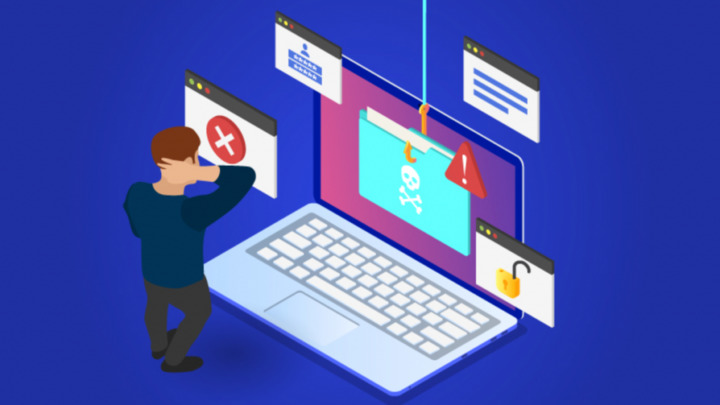Spotting Red Flags: Recognizing the Telltale Signs of Phishing Scams

Phishing scams are among the most common and persistent online threats facing individuals and businesses today. These attacks use various deceptive tactics to trick people into revealing sensitive personal or financial information, such as passwords, credit card numbers, or social security numbers. While the methods used by cybercriminals are constantly evolving, several common indicators can help you spot a phishing attempt before it’s too late.
In this article, we’ll discuss these telltale signs and explore the different types of phishing scams you may encounter. By learning to recognize the red flags and taking proactive steps to protect yourself, you can reduce your risk of falling victim to these dangerous scams.
Common Indicators of Phishing Attempts

Common indicators of phishing attempts can be broken down into several categories:
- Suspicious sender email address or domain;
- Unusual requests for personal or financial information;
- Urgent or threatening language;
- Poor grammar or spelling errors in the email;
- Suspicious attachments or links;
- Requests for a password or login information.
Suspicious Sender Email Address or Domain
A suspicious sender email address or domain is one of the most common indicators of a phishing attempt. Cybercriminals often use email addresses or domains that closely mimic legitimate ones to trick people into thinking the message is from a reputable source. For example, instead of “[email protected],” a phishing email may come from “[email protected]” or “[email protected].”
To check if an email address is legitimate, hover over the sender’s email address or click on the sender’s name to see if it matches the company or organization’s official website. If it’s a personal email account or a domain that doesn’t match the sender’s claimed affiliation, it’s likely a phishing attempt.
Another way to verify the email’s authenticity is by checking the email’s header information. The header contains technical details on the email’s origin, and it’s usually hidden from view. You can usually access the header information by clicking on your email client’s “details” or “properties” option. If the header information does not match the sender’s claimed affiliation, it’s likely a phishing attempt.
Unusual Request for Personal or Financial Information
Another common indicator of a phishing attempt is an unusual request for personal or financial information. Such scams often try to trick people into providing sensitive information like passwords, credit card numbers, or social security numbers.
These requests may seem urgent, and the attacker may use language designed to create a sense of panic or urgency. For example, a phishing email might claim there is suspicious activity on your account and ask you to provide your password or credit card number to verify your identity.
If you receive an email or message requesting personal or financial information, verifying its legitimacy before responding is crucial. If you’re unsure about the request, contact the company or organization directly using their official phone number or email address to confirm its legitimacy.
Legitimate organizations rarely ask for sensitive information through email or text messages. If you’re asked for personal or financial information via email or message, it’s likely a phishing attempt. Be cautious and do not provide any personal information until you can confirm the request’s legitimacy.
Urgent or Threatening Language
Phishing scams often use urgent or threatening language to create a sense of panic and pressure people into responding quickly. For example, these emails may contain urgent messages like “Your account has been compromised” or “Your payment is overdue” to create a sense of urgency and trick you into taking immediate action.
Attackers may also use threatening language to intimidate you into providing sensitive information or clicking on links. For example, a phishing email might claim that your account will be suspended if you don’t take immediate action or threaten legal action if you don’t comply with their demands.
It’s essential to stay calm and not be intimidated by these messages. Take a closer look at the email and verify the request’s legitimacy before taking any action. If unsure, contact the company or organization directly using their official contact information to confirm the request’s legitimacy.
Remember, legitimate companies and organizations will never threaten or intimidate you into providing sensitive information or taking immediate action. That is why an email containing urgent or threatening language is likely a phishing attempt.
Poor Grammar or Spelling Errors in the Email
The email’s poor grammar or spelling errors can also be a red flag for a phishing attempt. Phishing emails are often written quickly and hastily, and attackers may not pay close attention to spelling, grammar, or punctuation.
If you receive an email with obvious spelling or grammar errors, it’s essential to take a closer look at the message and verify its legitimacy. Legitimate organizations typically take the time to proofread their messages and ensure they are error-free.
Attackers may also use machine translation to create phishing messages in different languages, leading to poor grammar or awkward phrasing.
However, it’s also worth noting that some phishing messages may be well-written and appear professional, so the absence of poor grammar or spelling errors does not necessarily indicate that an email is legitimate.
Always exercise caution when reviewing emails and look for other signs of phishing, such as suspicious links or unusual requests for personal information.
Suspicious Attachments or Links
Suspicious email attachments or links are also common indicators of a phishing attempt. Attackers may use attachments or links to infect your device with malware or trick you into providing personal or financial information.
Attachments may include files like documents, PDFs, or ZIP files, and links may direct you to fake websites that look like legitimate ones. These fake websites often ask you to provide sensitive information like passwords, credit card numbers, or social security numbers.
To avoid falling for these types of scams, it’s essential to exercise caution when receiving attachments or links from unknown senders or from senders you were not expecting a message from. Never download an attachment or click on a link if unsure about its legitimacy.
Always hover over the link to see if the URL matches the organization’s official website. If it doesn’t, it’s likely a phishing attempt. Similarly, if the attachment is from an unknown sender or has an unusual file type, it may contain malware or be a phishing attempt.
Requests for Password or Login Information
Attackers often send messages claiming to be from legitimate organizations, asking for login credentials, passwords, or other sensitive data.
These messages may claim that your account has been compromised or that there is unusual activity on your account and ask you to provide your password to verify your identity. Attackers may also use fake login pages to trick you into providing your login credentials, which they can use to access your account.
It’s important to remember that legitimate organizations never ask you to provide your password or login information through email or messages. Therefore, if you receive a message requesting this data, do not respond or click on any links provided in the message.
Types of Phishing Scams

There are various types of phishing scams, each designed to trick victims into leaking their sensitive information. Some of the most common types include:
Deceptive Phishing
This form is known as the most frequent type of phishing scam. It involves sending a large number of emails that appear to be from legitimate sources, such as banks or popular websites. These emails contain a link to a fake website that looks identical to the legitimate one. Victims are then tricked into entering their login credentials, which the attacker can use to steal their personal information.
Spear Phishing
This type of phishing is considered a more focused form in which attackers research their victims and tailor their messages accordingly. Spear phishing often focuses on top-level executives or employees with access to valuable company data. Attackers may use information gathered from social media or other sources to make their messages appear more convincing.
Clone Phishing
It involves creating a fake email that appears to be a legitimate reply to an earlier message. I.e., the attacker uses the original message to create a nearly identical email but with a malicious link or attachment included. Victims may be more likely to fall for this type of phishing because the message appears to be a legitimate response to an earlier conversation.
Whaling
Whaling is phishing that focuses on top-level executives or other individuals with access to valuable company information. Attackers use social engineering techniques to trick victims into revealing their login credentials or other sensitive data. In addition, whaling attacks often use urgent or threatening language to cause a sense of immediacy.
Vishing
Vishing, or voice phishing, is a type of phishing that uses phone calls instead of emails. Attackers may call victims pretending to be from a legitimate organization, such as a bank or government agency, and use social engineering tactics to obtain sensitive information.
Smishing
Smishing is a type of phishing that uses SMS messages instead of emails. Attackers send text messages that appear to be from a legitimate source, such as a bank or retailer, and ask victims to click on a link or provide sensitive information. Smishing messages may also contain a phone number to call, which can lead to a vishing attack.
Tips for Avoiding Phishing Scams

Phishing scams are becoming increasingly sophisticated, making it essential to stay vigilant and take steps to protect yourself from these attacks. Here we go for some tips to help you avoid falling victim to such scams:
- Verify the sender’s identity: Check the sender’s email address carefully before responding or clicking on any links. Scammers often use email addresses that appear legitimate yet contain slight variations in spelling or domain names. If unsure about the sender’s identity, contact the company or organization directly to verify the email’s legitimacy.
- Do not click on suspicious links or attachments: If you receive an email with a suspicious link or attachment, do not click on it. These links and attachments can contain malware that can compromise your system or steal your personal information.
- Be cautious of urgent or threatening language: Phishing emails often use urgency or fear tactics to trick you into taking action. If you receive an email that claims your account has been compromised or that your account will be closed if you don’t take immediate action, be cautious. Take the time to verify the email’s legitimacy before clicking on any links or entering any personal information.
- Keep your software and antivirus up-to-date: Ensure that your operating system, antivirus software, and web browser are up to date to protect yourself from new phishing scams. Updates often contain security patches that address known vulnerabilities.
- Apply two-factor authentication: It adds an extra layer of security to your accounts by demanding a second form of authentication along with your password. This can help protect your accounts from illicit access, even if your password is compromised.
- Educate yourself and your employees: Phishing scams can target anyone, so it’s essential to educate yourself and your employees about the signs of such scams and how to avoid them. In addition, provide training and resources to help your employees recognize and report suspicious emails and encourage them to follow best practices for online security.
Conclusion
In conclusion, phishing scams remain a significant threat to online security and can cause considerable damage to individuals and businesses.
By following the best practices outlined in this article, you can significantly reduce the likelihood of becoming a victim of a phishing attack. Finally, it is essential to report any suspicious activity promptly to the appropriate authorities to protect yourself and others from these malicious attacks.
In summary, by remaining vigilant and taking proactive measures to protect your online security, you can stay safe from phishing attacks and protect your sensitive information from unauthorized access.
